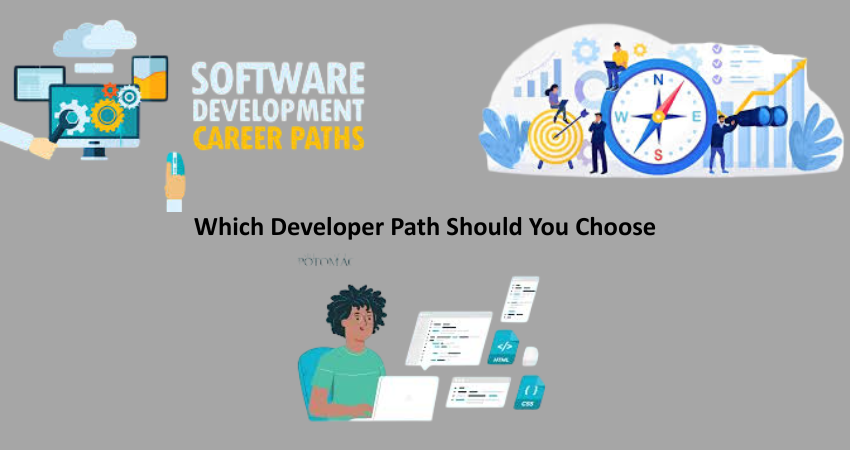
Introduction
The endless digital expanse has made learning to code the most accessible and desirable ever. The faint unsteady steps into tech have before him- the new journey; the toughest decision is which developer pathway to be taken. It can feel entirely confusing at times. Do you visualize yourself as someone who works in front-end development, applying his skills to visual design and user experience? Or visualizing yourself as someone behind-the-scenes, performing back-end processing, database and server managing? Or how about full-stack, which combines the benefits and responsibilities of both?
Selecting a suitable developer path is vital, as it directly affects your learning journey and also concerning career satisfaction, remuneration potential, and promotions. There are different skills, mindsets, and sometimes even personalities required in each of the roles. Some stress design and creativity, while others require a strong focus on logical problem-solving skills and profound knowledge of data structures and algorithms. This article breaks down the most common development paths and weighs their pros and cons, guiding you with the identification of the one which will best suit your own goals and strengths.
Front-End Development: The Visual Side of the Web
What Front-End Developers Do
Front-end development encompasses that portion of an application or website through which users directly interact. It involves using languages such as HTML, CSS, and JavaScript in order to create an application’s layout, design, and interactivity. In other words, anything you see on the front-end of a web application-from buttons to images, animations to typography-was made possible by developers working on the front-end. They cooperate with designers and UX guys alike, making sure the website not only looks great but also works well across different browsers and devices and different-sized screens.
Because front-end development is user-facing, these developers must possess an eye for detail. It’s about putting mock-ups into action, but not just a static screen; it’s about creating something dynamic, responsive, and engaging for users. Most front-end developers also know about some sort of framework within which they’re working, whether it is React, Vue.js, or Angular. They should also consider responsive design, accessibility, and performance optimization issues.
Who Should Choose Front-End Development
Front-end development offers a great avenue for those who like to mix design and logic. It’s best for those who are visually oriented and love the challenge of solving problems in an almost creative sense. Here, you can let your imagination and creativity shine in a technical environment. On a higher plane, many developers find fulfillment just in being able to see the direct impact of their work.
Another reason for taking up front-end development is the comparatively easy entry into the profession. A good number of developers start out here because html and css are much easier to learn as compared to server-side languages. As an ever-shifting market environment where tools and best practice recommendations change regularly, front-end programming calls for ongoing education. If you have a little flair for graphic design and stay up-to-date with the latest web trends, creating alternative interactive experiences will turn out to be a creatively challenging endeavor.
Back-End Development: Powering the Logic Behind the Scenes

What Back-End Developers Do
They are known as the back-end developers-the architects of the web-in terms of programming languages, and they do all building and construction related to the technologies to be used on the front end. This would include everything from servers to databases, application logic to API work-this is the backend. While users do not directly interact with a backend system, it makes applications functional, secure, and scalable. A backend developer works with the server-side languages like Python, Java, PHP, Ruby, or Node.js.
They usually utilize databases such as MySQL, PostgreSQL, or MongoDB to manage the data. The tasks include creating APIs to serve data to the frontend, implementing user authentication systems, writing server logic, optimizing database queries, and ensuring these systems run reliably and securely. Maintaining peak performance and scalability would mean that a site will be able to deliver resources efficiently under heavy traffic, even with a lot of application interactions. This is a less-glamorous side of the business but one that is very important in all web applications.
Who Should Choose Back-End Development
Do you like working with logic, algorithms, and data? Then back-end development is a good choice for you. If you are the one who loves solving puzzles, debugging troubles, or going into technical details, this path would come naturally to you. These are also the kinds of people who like to construct infrastructure rather than design user interfaces.
This path usually requires a deeper knowledge of programming concepts and system architecture. Back-end development also provides tremendous opportunities, especially in those fields more dependent on data processing, such as fintech, SaaS, and enterprise software. If you’re passionate about creating the engines behind various websites while dealing with some very complex issues impacting a great number of people, then back-end development is an interesting road.
Full-Stack Development: The Best of Both Worlds
What Full-Stack Developers Do
Full-stack developers have proficiency in both front-end and back-end, which places them in a unique position to carry out all the steps of building a web application from start to finish. They are jacks-of-all-trades, more than capable of carrying any task, from designing responsive UI components to managing server infrastructure and databases. This twofold ability places full-stack developers in high demand within small teams and startups, where versatility and adaptability are a must.
Developers generally apply JavaScript on both front end and back end, using frameworks like React and Node.js, but many will have additional skills in another programming language or tool. This work generally involves developing RESTful APIs, integrating third-party solutions, setting up deployment pipelines, and debugging full-system workflows. A full-stack developer must be able to think anywhere close to holistically, bridging the divide between what the user sees with their eyes and how the system works under the hood.
Who Should Choose Full-Stack Development
If you’re someone who likes variety in your work and savors understanding how all pieces work together in the system, your shot full-stack development would prove worthwhile. It’s perfect for those problem solvers who wanted to touch all parts of the procedure. The plus point for full-stack developers is that they are able to switch between roles of front-end and back-end as and when needed, making them highly valuable in the job market because of their flexibility and value. But at the same time, it can be a strenuous career path as mastering lots of varied skill sets usually comes with steep learning curves and massive expectations from full-stacks. Strong time management and a proactive approach are a must to keep pace with the incessantly changing technologies. The flexibility and independence it offers, along with the possibility to work on a freelance basis or follow entrepreneurship, makes full-stack development compelling for most people.
DevOps and Site Reliability Engineering (SRE): Ensuring Smooth Deployment
What DevOps and SRE Professionals Do
The professionals under the DevOps and Site Reliability Engineering (SRE) umbrellas have been integral in deploying and maintaining a web application. They may not be termed “developers” in the traditional sense, but they have made use of programming and scripting to automate infrastructure tasks, monitor system health, and safely and reliably deploy code. The primary goal is to optimize the active-passive component between development and operations, ensuring efficient application running environments in accordance with production procedures.
DevOps engineers will specify tools, such as Docker, Kubernetes, Jenkins, AWS, or Azure, to automate deployment pipelines, server environment configuration, and monitoring systems. For example, an SRE will go beyond deploying most of these applications by building fault-tolerant systems for services and maintaining some service-level objectives (SLOs) to guarantee system reliability. They all use languages such as Bash, Python, or Go to write their automation scripts to manage scaling, alerting, or logging.
Who Should Choose DevOps or SRE
The path suits those who are addicted to automating everything and building infrastructure that works at scale. If a person enjoys Linux systems and cloud computing, as well as designing a better approach to eliminating operational bottlenecks through code, then DevOps or SRE is likely to call. Most of these roles are those of backend developers who want to deepen their knowledge in deployment and infrastructure management.
There is an essential foundation in networking, containers, and CI/CD processes. It’s in demand now more than ever, as companies shift toward more cloud-centric and microservice-oriented architectures. This probably is a good technical option that is behind-the-scenes, very much mission-critical, and well-paying.
Specialized Paths: Data Science, Mobile Development and Game Development

Alternative Developer Career Tracks
Apart from traditional avenues of web development lie specialized niches such as data science, mobile app development, and game development. Data scientists derive their insights from massive amounts of data using programming, typically Python or R, along with statistics and machine learning. Mobile developers specialize in building apps for iOS and Android using languages and technologies like Swift, Kotlin, or Flutter. On the other hand, game developers build interactive experiences and video games with engines such as Unity or Unreal.
Each of these avenues requires a distinct skill set and almost laser focus on particular technologies. They often combine a bit of creativity and technical know-how and can prove to be very rewarding within targeted industries. For example, data science has greater importance in finance, healthcare, and technology, whereas mobile development is an ever-growing field as smartphones and wearables continue to spread like wildfire.
Who Should Consider These Roles
Data science will probably fit well into your profile if you have a strong interest in mathematics, statistics, and machine learning. If you build apps for consumers and enjoy working with touchscreen UIs, mobile development would be a suitable choice. Game development is suited to the creative side of the mind that also likes to deal with complex graphical and performance problems.
Because of these roles’ particularities, take time to research on career longevity and daily work before you dive in. Some may include advanced studies or domain-specific knowledge (like AI or physics). If you have unparalleled zeal for any one of them, opportunities for doing fun and impactful work are plentiful.
Conclusion: Choosing Your Best Path Forward
Choosing a developer career is less about the “best” option and more about the appropriate one for your personality, interests, and long-term careers. Each role, be it front-end, back-end, full-stack, DevOps, or specific field specialization, has its own hurdles, learning, and rewards. The key is to start by looking into what you like doing. For instance, do you like designing things or simply logical problem-solving? Do you want to interact with users on the front lines or work behind the scenes?
Try doing mini projects in different areas to discover what inspires you the most. At this stage, you do not have to make a commitment; many developers shift into new roles with growth. Use online training, read documentation, contribute to open source, and keep talking to people that are presently in the field. Above all, search for a path that keeps you wanting to learn. Passion and persistence are the most important, not perfection.
Paths through the tech world are rarely direct. You may begin in front-end development and discover a love for back-end systems-or start with DevOps and shift into full-stack. Your road is your own, and the skills you gain with each step only increase your options. The most successful developers are those who did not know everything on day one-but rather those who chose a direction, committed themselves to becoming better, and continued building.